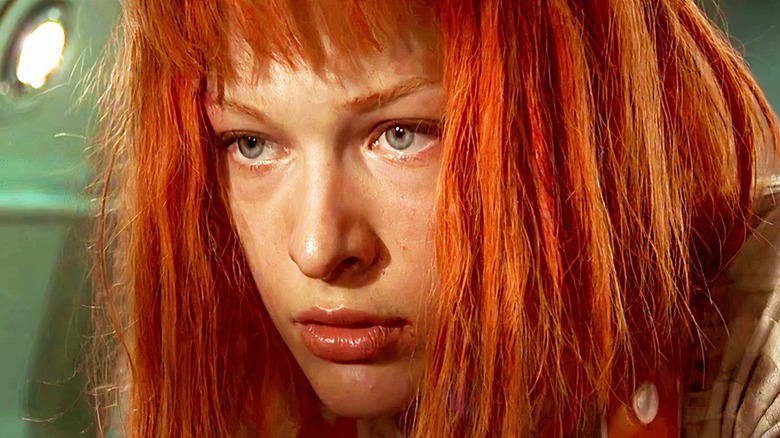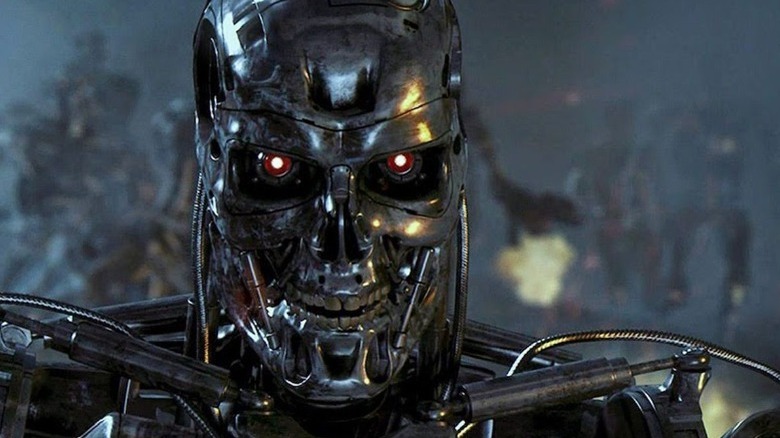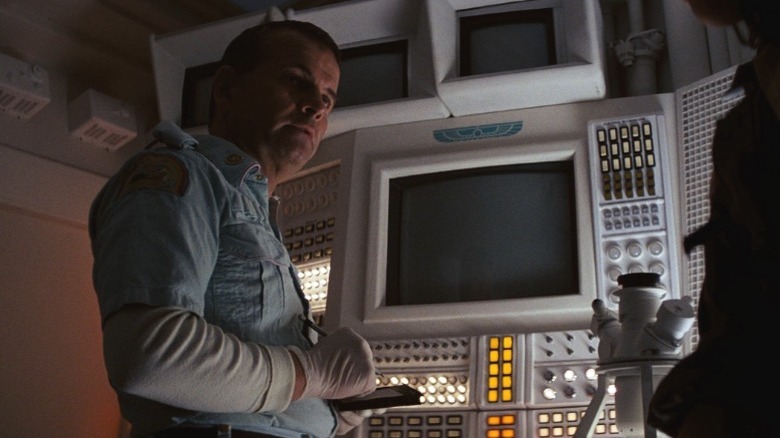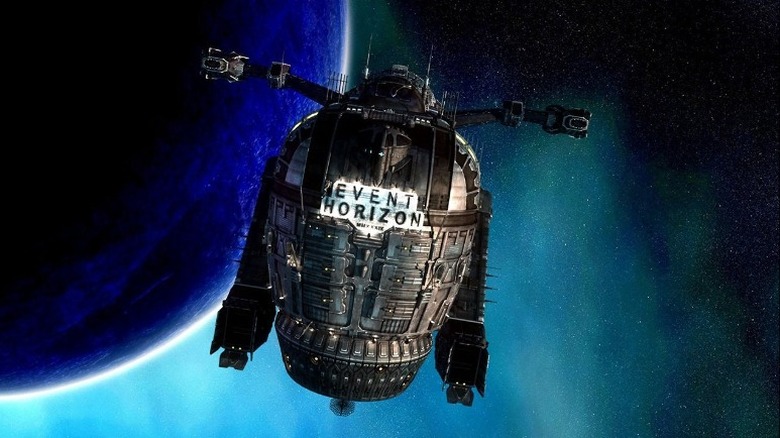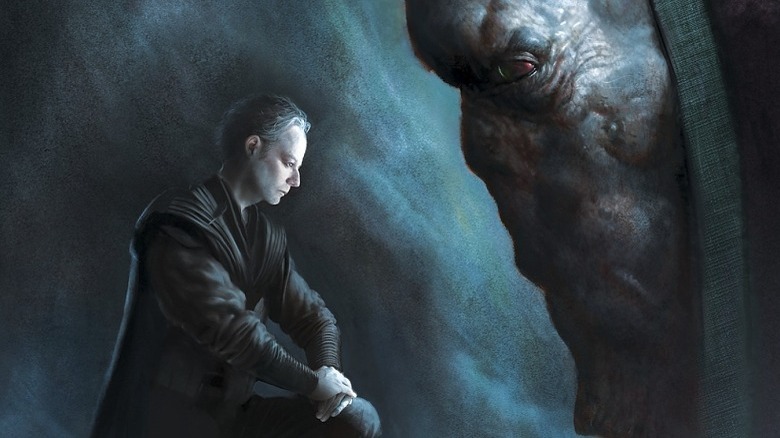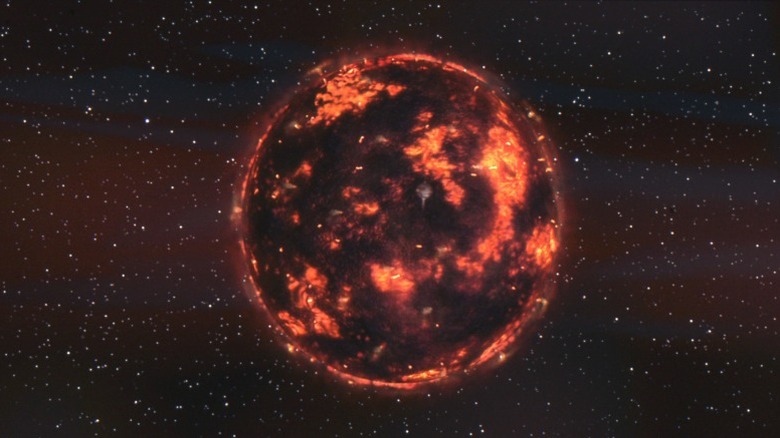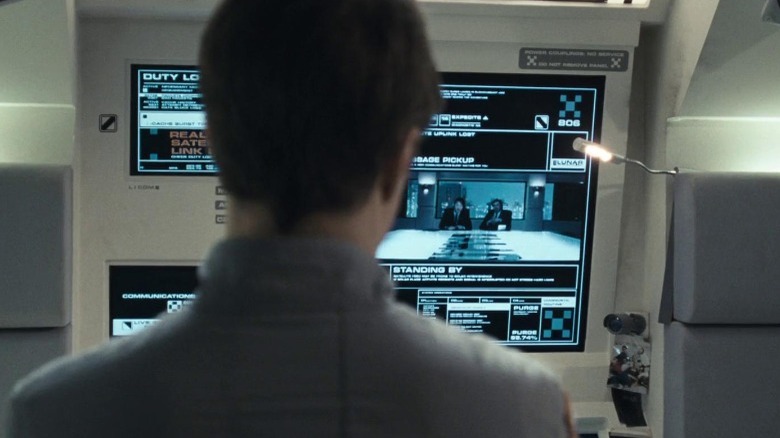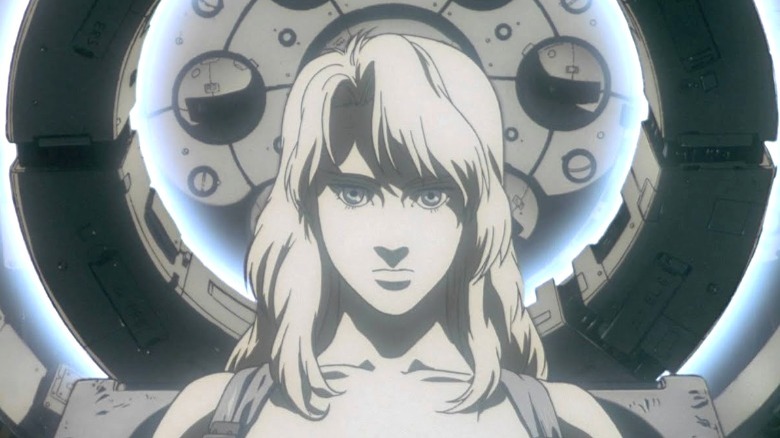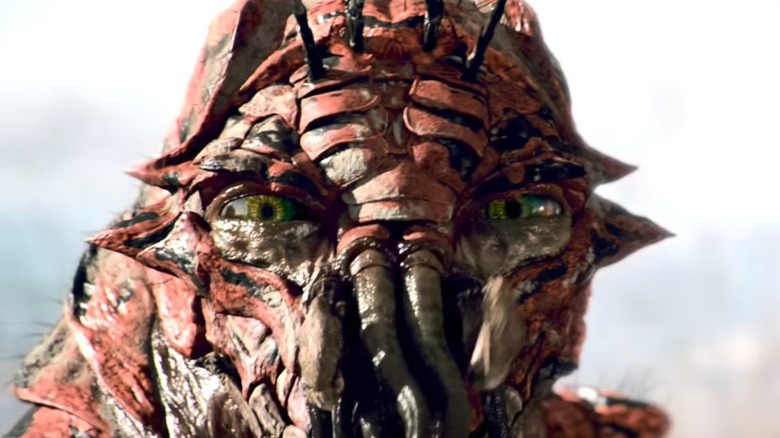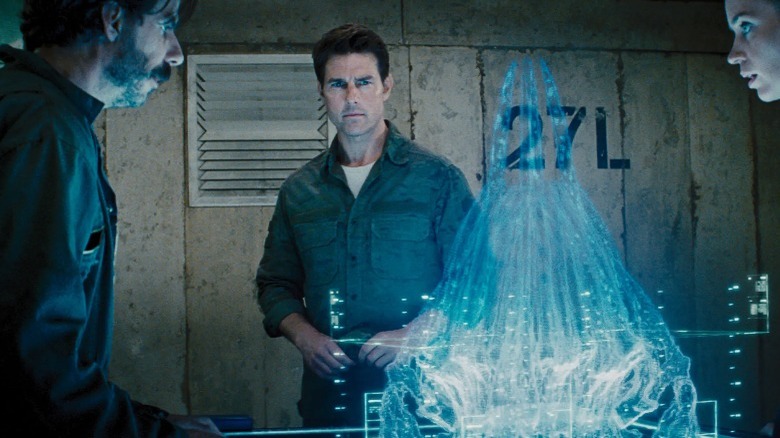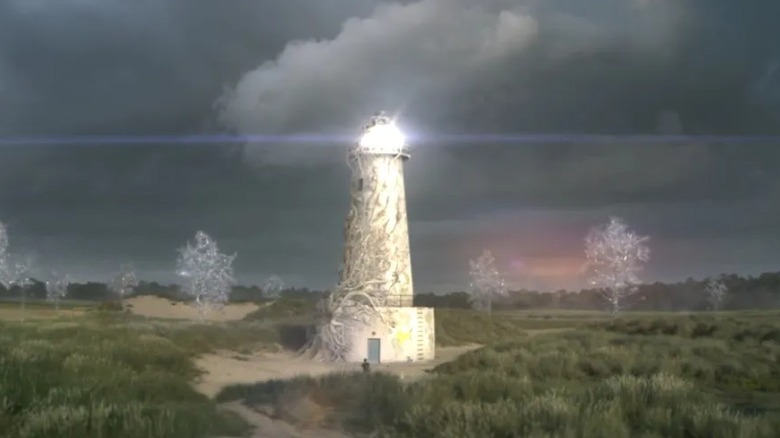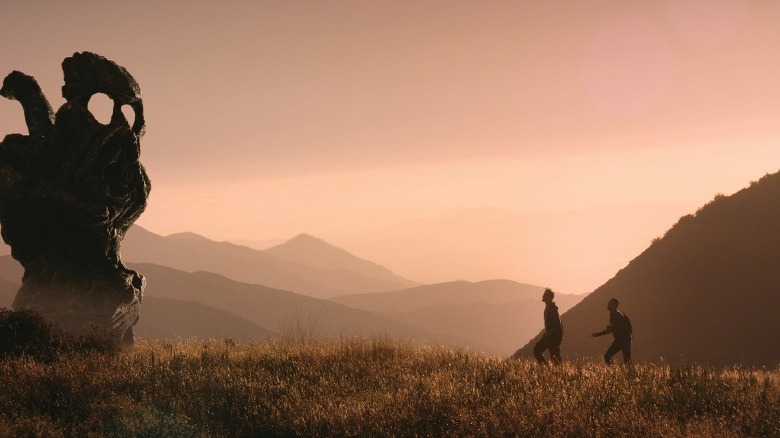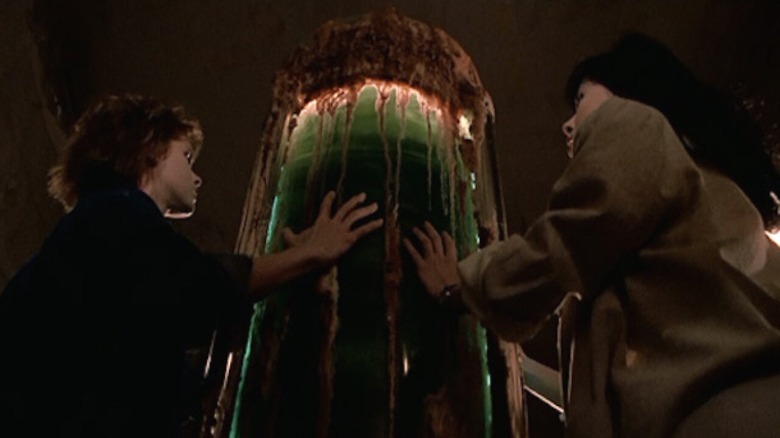Terrifying Sci-Fi Movie Villains You Never Actually See
There's real terror to be found in the iconic silhouettes of characters like Darth Vader and Clive Barker's infamous Hell Priest, Pinhead. Sometimes horror is lurking in an ordinary human face like that of Baron Harkonnen, with those dead, hungry eyes, or Mark Strong's mad astronaut in "Sunshine." Sometimes the beings with the most awful import are the ones that go unseen.
H.P. Lovecraft didn't corner the market on faceless dread, and the hidden puppeteers of a fragile society don't need tentacles to inflict the worst upon us. Sometimes, all they need to do is promises that things will get worse for our heroes. And sometimes they are that awful to behold, so terrible and full of dark awe that our imaginations are left to piece together what they might look like. Even without knowing who or what they are, these villains are as immortal as their more recognizable peers. Here are some of the scariest bad guys in sci-fi that we've never seen. Maybe we should be grateful for that.
Skynet — The Terminator
Artificial intelligence is inherently invisible to us. Attempting to picture it results in glimpses of green-tinged binary code, satellite links, and war machines moving without human control. Skynet doesn't have a face, its attempts to use a human mask in "Terminator: Salvation" and "Genisys" notwithstanding. Skynet is a self-aware set of electrical impulses, acting on a command of self-preservation that doesn't include the humans that built it and now want to shutter it. Skynet uses every system it can access to complete that mission.
It lacks empathy by design. Its logic is impeccable, and its program is ruthless. It is (and in James Cameron's defense, this is likely to be deliberate commentary) the horrifying apex of the military-industrial complex. Worse, it adapts. As Cameron noted in early 2022, Skynet's reliance on military hardware is optional. We continually provide it with new tools, and an AI with access to deepfakes and social media could wrap us up in a matter of weeks without ever interfering with a nuke silo. The most horrifying thing about this unseen enemy? Something very much like it could be doing exactly that — right now.
The board of Weyland-Yutani — Alien
In 1979's "Alien," all that we knew of Weyland-Yutani were corporate logos and a grim interpretation of company whims. "Aliens" gave us a glimpse of some of their board managers, sour people in retro-futurist brown suits easily swayed by greasy swindlers like Carter Burke (Paul Reiser). Ridley Scott would later return to the world he made in "Prometheus," introducing us to Peter Weyland (Guy Pearce) and his prodigal android son, David 8 (Michael Fassbender). Between all of this is the looming silence of Corporate.
Someone signed off on the order to investigate LV-426. Someone in the company still maintains the files on David 8's experiments as seen in the "David's Lab" short film. Someone knows all the company's dirty little secrets, and they're probably part of the unseen executive board of Weyland-Yutani. Like the Xenomorph Queen, the results of their actions leave scars everywhere, but their existence is only hinted at until confrontation is inevitable. With Noah Hawley's series set to explore Earth in the years before LV-426, it may be we'll finally get a look at these secretive capitalist monsters and find out just how much they know about the Engineers and their bloody creations.
The Warp — Event Horizon
"Event Horizon" remains the No. 1 cult horror movie for "Warhammer 40k" fans, and a skim of the relevant lore shows why. The Event Horizon is an experimental ship with a new kind of engine. It folds space, letting the ship punch through to a new location. The problem, as the "Warhammer" gang knows, is that there's some Bad Weird Stuff in the rift between those two points, and as this film opens, the Event Horizon is now alive with the entities that live in a dimensional rift so awful that it's indistinguishable from the theological idea of hell.
The audience never lays eyes on the entities in control of the experimental vessel, and you know what? That's fine. We see more than enough in the footage of these space demons puppeteering the previous crew, and even that's cut down from a pile of missing footage that's rumored to be so much worse. It's enough to cue the genre-savvy captain (Laurence Fishburne) into getting the heck out of there, but it's already too late. Where this crew's going, they don't want to see what's coming for them. Neither do we.
Darth Plagueis — Star Wars
Darth Plagueis the Wise doesn't have a portrait that the Jedi would show you. That's because there's a bunch of history that got crossed out when Disney took over the "Star Wars" franchise. James Luceno's novel, which was meant to flesh out the story of Darth Sidious' malicious master, dropped shortly before the lines were redrawn between Legends and canon. In Lucerno's book, he's an unsettling-looking Muun, an arcanist obsessed with transcending mortality. He was the mind behind using midichlorians to influence future generations, and it was his apprentice, Darth Sidious (Ian McDiarmid), who slew him.
A living Plagueis has yet to appear in any new official work, and the above is now speculation. He earns offhanded mentions in works like "Shadows of the Sith," and it's a sourcebook for the tabletop RPG "Star Wars: Force and Destiny" that claims he's still a Muun, even though that's not a firm canon source. Yet, this much is true. Without Plagueis, the galaxy would never have faced his murderous apprentice. There's little doubt we'll meet Plagueis again, and when we do, he'll truly be a dark force.
The Great Evil — The Fifth Element
At its heart, "The Fifth Element" is a corny, racy European comic that got toned down for global release. There's a visible connection between Leeloo (Milla Jovovich) and Barbarella (Jane Fonda) — a kind of celestial innocence tinged with earthy adoration for the human experience. Of course, great good has to face great evil. Despite the intimate look we get at Leeloo, we see nothing of the great evil that's manipulating Zorg's greed.
The Great Evil is represented by a planet-shaped orb set in motion by some cosmic force. Sentient anti-matter or an anti-life entity, it exists simply to be the darkness, to be hateful, and to destroy life. It communicates with a kind of telepathy, and it's implied to have consumed communication satellites for its purposes. However, that communication inflicts pain. To hear the voice of this senseless evil is to be torn apart slowly from the inside as Zorg (Gary Oldman) experiences. Such pointless, pure evil is scary because of its incomprehensibility. What is its problem with us? It doesn't have one, it's content to hate. That's its only purpose. How awful.
Lunar Industries Management — Moon
Sit with it long enough, and the true horror of "Moon" sets in. It's not that a bunch of faceless corporate goons decided the most efficient way to run a lunar mining operation was to run it on a shoestring budget with a bunch of clones on standby. It's not how disposable the Sam Bell ( Sam Rockwell) clones are — to the point that a "rescue" crew is a murder and cover-up team. It's that if a totally fictional billionaire named "Biff Jessos" could do this right now, he would. The monster he (for purposes of parody) made is going to need that cloning tech if they want to keep the money rolling in.
It's the depressing apex of corporate myopia. In "Moon," society has cracked two of the biggest scientific mysteries. We can live in alien environments for an indeterminate period, and we've mastered genetics. And this is what we do with it.
The senior management behind this rotten state of affairs goes unseen. We get a glimpse of two middle managers, played by Benedict Wong and Matt Berry. It's easy to hate them, but they're scapegoats. We don't see the real monsters. We don't need to. They're already here.
The Puppet Master — Ghost in the Shell
The Puppet Master of both the 1995 film and Masamune Shirow's manga "Ghost in the Shell" is a formless foe. It activates several shells before it joins with Major Kusanagi, hijacking innocent people on its way to self-reliance. Another AI created by a government agency, the Puppet Master asks for recognition as a fully sentient being, but its empathy isn't all there yet. The cavalier way it treats its metaphorical series of taxi cabs is terrifying. It walks one shell into traffic on purpose, causing a hellish crash that's hard to forget.
The closest the Puppet Master comes to having a face of its own is when it takes over a half-built blonde cyborg. Once it joins with Kusanagi, we enter the realm of philosophy, and we are forced to ask ourselves what the power dynamic is like inside that cybernetic mind. Major Kusanagi seems recognizable, but her demeanor has changed. Did it change for the better or into something scarier than the Puppet Master? "Ghost in the Shell 2: Innocence" doesn't make it any clearer, beyond her loyalty to her friends. Glad she's on their side.
The hive's downfall — District 9
Yes, humanity is the real enemy in Neil Blomkamp's "District 9." However, the director's backstory for the stranded ship opens up some harrowing considerations. Talking to Gizmodo in a 2009 interview, Blomkamp describes the "prawn" hive mind as the species' strength and also its downfall. In his words, the ship was "meant to clip together with other ships" to centralize the resources each ship collects. The ship we meet loses its queen or central leadership due to a virus it picked up on some other world.
Now, that's not canon yet. That's just the thought Blomkamp started with when conceptualizing Christopher Johnson's people. It could have been a "War of the Worlds" style accident, biowarfare, or, ultimately, something more violent. Something terrible stranded a civilization with that much military might on our backwater world. Large or small, it's terrifying to consider what can bring even the mightiest of galactic powers down. Get your vaccines, and never take your helmet off on an unexplored world.
The Omega — Edge of Tomorrow
The Mimics of "Edge of Tomorrow" appear to be a hive mind linked not through a neural connection but a chronokinetic one. That rare sci-fi term means timey-wimey weirdness is on the menu as Tom Cruise quickly finds out when he gets drenched in the blood of one of the Alpha Mimics. The Alphas answer to a higher power, an Omega Mimic that we only get glimpses of by the end.
Functionally a biological AI, the Omega might not even be the top-tier leadership of this incomprehensible species. What little we see of it is disconcerting, though. A digital recreation by the intel team shows an orb above a throne of irregular tendrils. Cruise's character, William Cage, sees bits of it in motion in the finale, giving the Omega a classic cosmic horror design. Nothing else about the species is known — not their motivations, what they think about for fun, anything. All we have is their need to exterminate humanity and their scary control over time. The Omega is the only "face" we have for a nearly unstoppable extinction event. Fortunately, Tom Cruise has the plot armor to take it on.
The Shimmer — Annihilation
Possibly the scariest thing about the alien invader at the heart of "Annihilation" is that it probably has no idea what it's doing to us. It's on a completely different level of existence, and if it's communicating at all, it's through arcane biological changes to the environment and its denizens. All that we can perceive of it is the shimmer that veils the Southern Reach from the unchanged world. Its creations, like the screaming bear and the eerie duplicates, may be reactive responses to evolutionary stimuli, but what it all means, nobody can answer.
The film doesn't give away much on how exactly the transformation of the Reach started. The trilogy of novels by Jeff VanderMeer offers tantalizing clues about the lighthouse at the end of the film, and a glint from its lens that begins a series of changes in its keeper. Alex Garland's film doesn't engage or conflict with this premise, but the emptiness behind the Shimmer's effects is a chilling example of passive villainy. It's not evil. It's something else entirely. Yet, what it's doing is still too much for humanity to cope with.
God — The Endless
The entity that Camp Arcadia worships in directors Justin Benson and Aaron Moorhead's "The Endless" is not God as established religions would call it. This thing is far more likely to be one of Cthulhu's old golf buddies, slacking on Earth between apocalypses and enjoying the attentions of its little cult. It's unseen, just a shape in the dark and a charging black energy pursuing escaping prey. There's an unsettling, extremely Lovecraftian statue sitting in a field but no proof that's this thing's true form. All we have is what it does.
The entity has the "Event Horizon" playbook in hand, now with a rewind feature. Its cult is happily trapped in a time loop, playing games of fetch with its malignant deity and proving its faith by toying with the moon. The entity keeps other toys around, too, hapless travelers from across multiple eras, reliving horrible deaths. The worst is the man in the tent, whose repeating lifecycle is a mere five seconds before it ends in a bloody explosion. If dread Cthulhu lies dreaming, let's hope, for the sake of these poor souls, that this thing is due for a long nap.
The Anti-God — Prince of Darkness
Like a Waffle House cook down to his last bag of potatoes, John Carpenter does more with less. "Prince of Darkness" is the cheapest of his apocalypse trilogy, which includes "The Thing" and "In the Mouth of Madness," and one of his finest pieces of low-budget art is found in its formless villain. We meet Satan, sort of, as a canister of unsettlingly turgid Mountain Dew. We don't quite meet its maker and thank God for that. Literally, in this case.
Father Loomis (Donald Pleasance) sets the table for what the Anti-God is in a wonderful monologue about the church's cover-up of space alien Jesus and the eldritch horror hiding behind the veil of quantum physics. It takes a squad of collegiate scientists to prove him right, mostly by dying in terrible ways. The true architect of evil is locked away across dimensions, accessible only by ritualized conditions. It takes an awful sacrifice to keep the Anti-God there, and all we glimpse is a massive, bloated hand that seems to be lurching from ceaseless darkness. There's a chance that the sacrifice was for nothing, though, and the Anti-God is almost here.
